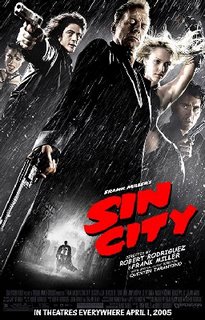 The ciphers of the Western I understand well enough, but the same can't be said for pulp-noir mythology: What exactly are these pastiche retro-futures trying to tell us about contemporary America? It bothered me when I watched Batman Begins and it did so again when I turned to Robert Rodriguez's Sin City.
The ciphers of the Western I understand well enough, but the same can't be said for pulp-noir mythology: What exactly are these pastiche retro-futures trying to tell us about contemporary America? It bothered me when I watched Batman Begins and it did so again when I turned to Robert Rodriguez's Sin City.Bizarrely I felt I'd come a step closer to breaking the code when I watched Brian Sewell touring the Senate rooms of Siena last night. The frescoes on the walls depict two alternative visions of civil society: one governed by manifestations of all the virtues, the other presided over by their wicked inversions.
So perhaps these dark modern fantasies betray a pre-modern fear of evil ruling in parallel. They certainly flaunt a very medieval carelessness with anachronism and chronological time.
Sin City grabs your attention and holds it in a powerful grip for about an hour. Thereafter interest steadily slackens. The movie's on-screen style is exhilarating, but ultimately no substitute for good dialogue and storytelling.
In order to give artist Frank Miller co-director status Rodriguez had to resign from the Directors' Guild. He then worked hard to recreate the edits and textures of Miller's graphic novel taking the comic-book physics he explored in the Mariachi series to their logical conclusion. He has also borrowed some of the visual techniques his buddy Quentin Tarantino explored in Kill Bill. (Tarantino guest directed a sequence here with Benicio del Toro and Clive Owen.) It's a film you should see if you are interested in the latest blue-screen wizardry.
As for the pulp-noir dystopia - my own preference is for those that are more obviously shunted into the future such as Blade Runner or the graphic novels of Enki Bilal.

No comments:
Post a Comment